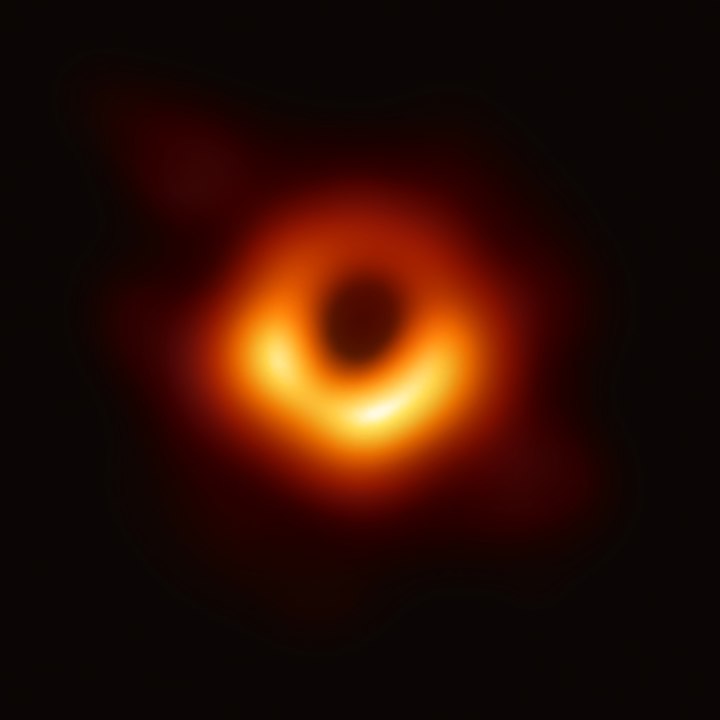
I learned this today. Light can’t escape from a black hole because of the curvature of space caused by gravity.
In physics, gravity is the weakest of the four fundamental forces. The forces are gravity, the electromagnetic force, and the strong and weak forces that exist in atoms. Isaac Newton described gravity as a force whereby any two bodies are attracted to each other, depending on their masses and their distances from each other. This is why the moon is attracted to the Earth, and the Earth is attracted to the sun.
Albert Einstein rethought gravity in his Theory of General Relativity in 1915. He said that gravity is not a force. He said that objects want to travel through space in a straight line, but that space is not straight. Objects with mass curve the space around them and objects moving through space follow these curves. If an object has enough speed, it will keep moving on past the object, and if it doesn’t have enough speed, it will get caught in the curve around the object, going into orbit.
A good way of thinking about it is by using a taught piece of black cloth. When balls of different weights are dropped on the cloth, they sink down to different depths depending on their weights and curve the cloth around them. If a ball is rolled across the cloth and misses all of the dips caused by the other balls, it will go in a straight line. If the ball catches a dip but has enough speed, it will catch the dip, curve, and then carry on. If the ball catches a dip but doesn’t have enough speed, it will start to circle around the ball making the dip.
In space, the more mass an object has, the more gravity it has. Black holes have more mass than any other object in the universe.
A black hole is formed when a star collapses in on itself. As stars age, they burn through all of their fuel. Through the process of nuclear fusion, they turn hydrogen atoms into helium, giving off energy. Once they have converted all of their fuel, they start to die. Some stars turn hydrogen into heavier metals, but at some point, all stars stop burning. At this point they have no heat energy left in their cores and they have no internal pressure left to combat their enormous gravity and they collapse in on themselves in a supernova explosion. A star needs to be a minimum of three times larger than our sun for this to happen. When it collapses, it becomes incredibly small but it still has the mass of the original star, so it also becomes unimaginably dense. For example, a star ten times larger than our sun becomes the size of New York City.
The denser something is, the more gravity it exerts. The black hole is so dense, and has such high gravity, that anything caught in its gravity gets sucked in. Imagine our balls on the stretched black material. A bowling ball placed on that material is going to pull it down. Anything rolling across the material might get caught in the dip made by the bowling ball and start circling around it. However, if the object is moving fast enough, it might slip into the dip, curve slightly and then carry on. This is what happens to light when it passes large objects. It is attracted by their gravity, but it is moving too fast to get caught and carries on moving, having been curved ever so slightly.
Now, imagine the bowling ball is compressed down to the size of a ball bearing. It still has the same mass as the bowling ball, but it is the size of a ball bearing. It is going to pull the material down much farther in the center and it is going to have a much steeper slope. The material above the ball bearing will be pretty much closed. If something comes too close and enters this dip, it will spin down much faster. It will not be able to get back out because the ball bearing is pulling the cloth down so far there is no way out. When light reaches this dip, it curves around the edge but, unlike with the bowling ball, the edge is so steep and wrapped on itself that all of the paths that the light takes point down into the dip. Light cannot escape from a black hole because there is no way out. Every direction that the light can go in, point back down into the black hole. And this is what I learned today.
Image By Event Horizon Telescope, uploader cropped and converted TIF to JPG – https://www.eso.org/public/images/eso1907a/ (image link) The highest-quality image (7416×4320 pixels, TIF, 16-bit, 180 Mb), ESO Article, ESO TIF, CC BY 4.0, https://commons.wikimedia.org/w/index.php?curid=77925953
Sources
https://astronomy.com/magazine/greatest-mysteries/2019/07/19-can-light-escape-from-black-holes
https://www.sciencefocus.com/space/why-can-gravity-escape-a-black-hole-but-not-light/
https://physics.stackexchange.com/questions/8477/why-cant-light-escape-from-a-classical-black-hole
https://socratic.org/questions/why-light-can-t-escape-from-a-blackhole-if-they-have-no-mass
https://en.wikipedia.org/wiki/Black_hole
https://en.wikipedia.org/wiki/Supermassive_black_hole
https://en.wikipedia.org/wiki/Gravity
https://science.nasa.gov/astrophysics/focus-areas/black-holes
